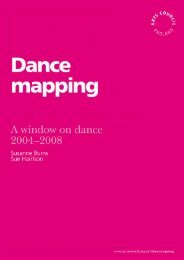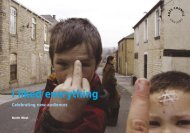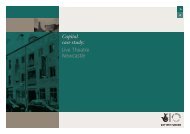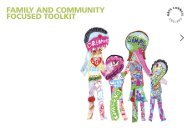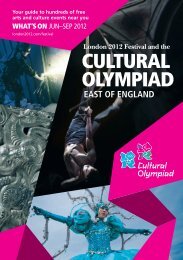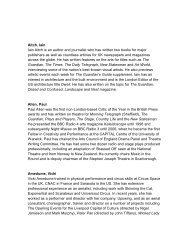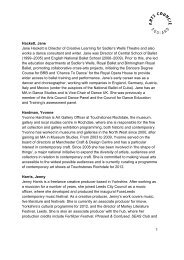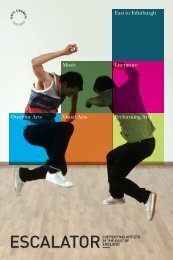What's art got to do with it? - Arts Council England
What's art got to do with it? - Arts Council England
What's art got to do with it? - Arts Council England
You also want an ePaper? Increase the reach of your titles
YUMPU automatically turns print PDFs into web optimized ePapers that Google loves.
5 Health<br />
13<br />
‘Art should not be seen as one of those activ<strong>it</strong>ies like physiotherapy that is<br />
ancillary <strong>to</strong> medicine; nor as alternative medicine. It is concerned <strong>w<strong>it</strong>h</strong> our<br />
common sensibil<strong>it</strong>y, and our shared vision of what life is about and how <strong>it</strong><br />
should be lived… Art should help us in medicine <strong>to</strong> minister <strong>to</strong> patients as<br />
whole persons living out their lives, enabling us <strong>to</strong> treat life in <strong>it</strong>s <strong>to</strong>tal<strong>it</strong>y.’<br />
John Davis, Professor Emer<strong>it</strong>us in paediatrics, Univers<strong>it</strong>y of Cambridge. Speech<br />
at A Vision of Caring Environments, Manchester, 2/3 November 1989<br />
Case study 1 22<br />
A healthy neighbourhood is safe, clean, inclusive, confident and creative. Local<br />
people can support the development of healthy neighbourhoods by:<br />
• taking responsibil<strong>it</strong>y for maintaining the pos<strong>it</strong>ive aspects of their neighbourhood<br />
• getting involved in local activ<strong>it</strong>ies<br />
• giving their skills, knowledge and time<br />
The <strong>art</strong>s are ideally placed both <strong>to</strong> motivate individuals and groups <strong>to</strong> take action<br />
and <strong>to</strong> give them some of the skills they need <strong>to</strong> be effective (organisation, team<br />
work, communication etc). In his research for Use or Ornament, Matarasso reports<br />
that of the 243 adults taking p<strong>art</strong> in <strong>art</strong>s projects, 52% said they felt ‘better or<br />
healthier’ and 73% were ‘happier’ since they st<strong>art</strong>ed taking p<strong>art</strong>.<br />
‘The <strong>art</strong>s bring a different dimension <strong>to</strong> clinical practice, that of the <strong>art</strong> of<br />
healing, and are complementary <strong>to</strong> the science base.’<br />
Sir Kenneth Calman, Former Chief Medical Officer<br />
A large-scale study of more than 10,000 people over a 14 year period (by Professor<br />
Lars Olov Bygren of the Univers<strong>it</strong>y of Umea in Sweden 23 ) showed that over the<br />
22 Gowan, Natasha, Healthy Neighbourhoods, King’s Fund, 1999<br />
23 Bygren, Lars Olov, Konlaan, Boinkum Benson, and Johansson, Sven-Erik, ‘Attendance at<br />
Cultural events, reading books or periodicals and making music or singing in a choir as<br />
determinants for survival’, in Br<strong>it</strong>ish Medical Journal 21-28 December 1996, Vol 313<br />
pp.1577-1580. Also ‘Vis<strong>it</strong>ing the cinema, concerts, museums or <strong>art</strong> exhib<strong>it</strong>ions as<br />
determinant of survival’ by the same authors, in Scandinavian Journal of Public Health, 28,<br />
2000. http://bmj.com/cgi/content/full/313<br />
/7072/1577?max<strong>to</strong>show=&HITS=10&h<strong>it</strong>s=10&RESULTFORMAT=&t<strong>it</strong>leabstract=Cultural&sea<br />
rchid=1020270327173_15977&s<strong>to</strong>red_search=&FIRSTINDEX=0&resourcetype=1,2,3,4,10


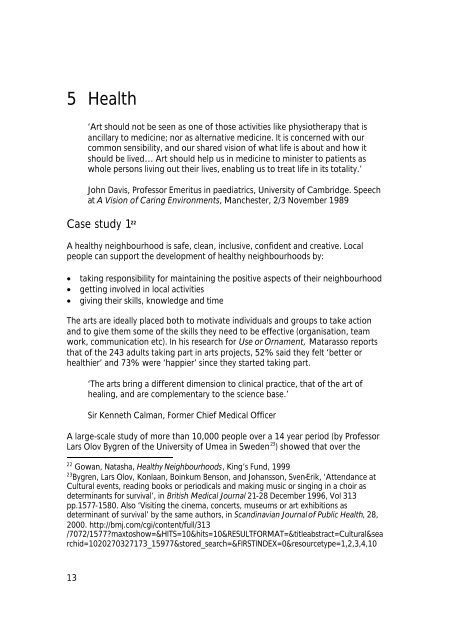

![More than potato prints [PDF 451.9 KB] - Arts Council England](https://img.yumpu.com/19437752/1/190x135/more-than-potato-prints-pdf-4519-kb-arts-council-england.jpg?quality=85)
